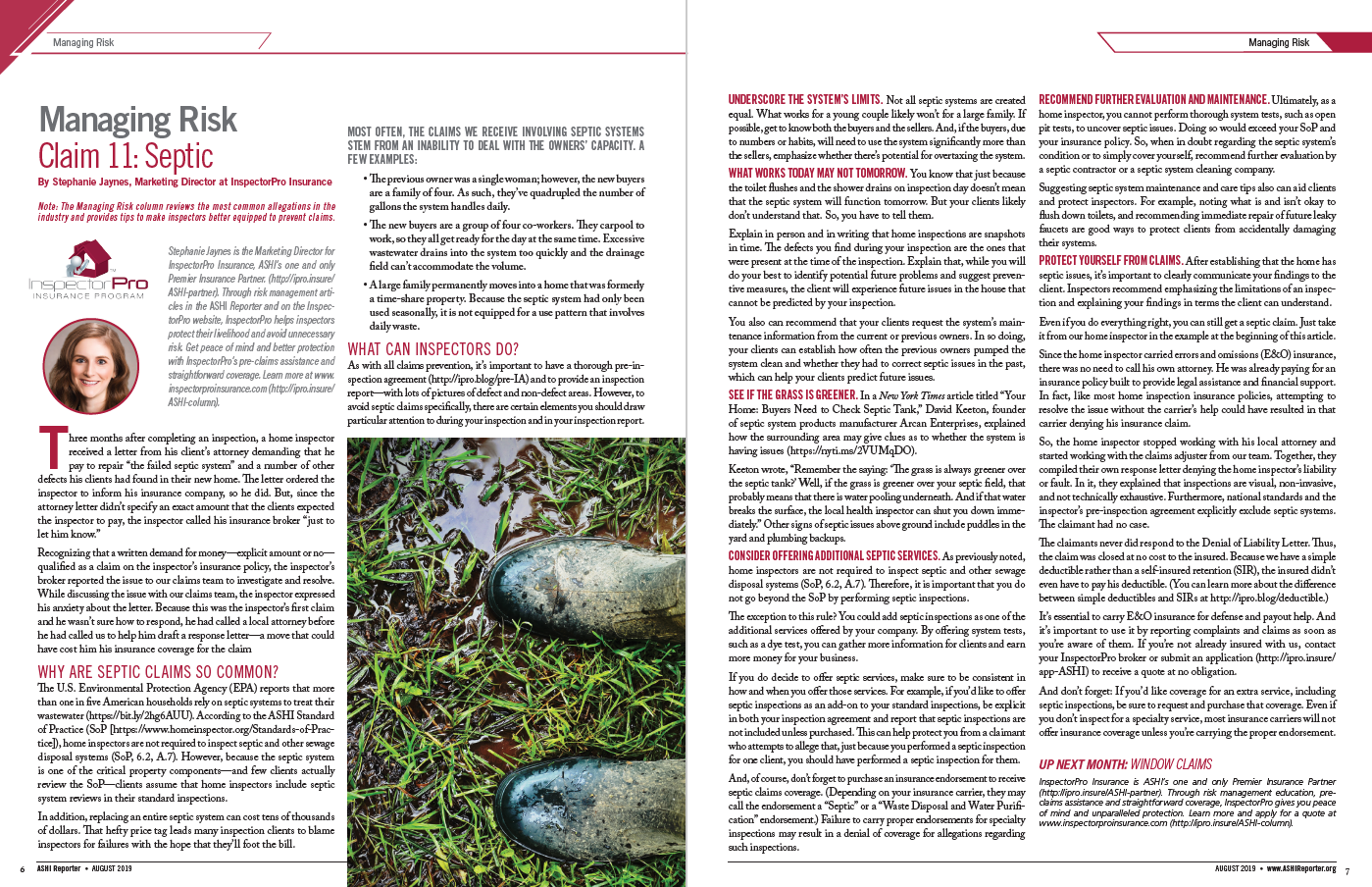Top E&O Claims Claim 11: Septic
Last Updated November 22, 2023

Three months after completing an inspection, a home inspector received a letter from his client’s attorney demanding that he pay to repair “the failed septic system” and a number of other defects his clients had found in their new home. The letter ordered the inspector to inform his insurance company, so he did. But, since the attorney letter didn’t specify an exact amount that the clients expected the inspector to pay, the inspector called his insurance broker “just to let him know.”
Recognizing that a written demand for money—explicit amount or no—qualified as a claim on the inspector’s insurance policy, the inspector’s broker reported the issue to our claims team to investigate and resolve. While discussing the issue with our claims team, the inspector expressed his anxiety about the letter. Because this was the inspector’s first claim and he wasn’t sure how to respond, he had called a local attorney before he had called us to help him draft a response letter—a move that could have cost him his insurance coverage for the claim.
 Why are septic claims so common?
Why are septic claims so common?
The US Environmental Protection Agency (EPA) reports that more than one in five American households rely on septic systems to treat their wastewater. According to the ASHI Standard of Practice (SoP), home inspectors are not required to inspect septic and other sewage disposal systems (SoP, 6.2, A.7). However, because the septic system is one of the critical property components—and few clients actually review the SoP—clients assume that home inspectors include septic system reviews in their standard inspections.
In addition, replacing an entire septic system can cost tens of thousands of dollars. That hefty price tag leads many inspection clients to blame inspectors for failures with the hope that they’ll foot the bill.
Most often, the claims we receive involving septic systems stem from an inability to deal with the owners’ capacity. A few examples:
- The previous owner was a single woman; however, the new buyers are a family of four. As such, they’ve quadrupled the number of gallons the system handles daily.
- The new buyers are a group of four coworkers. They carpool to work, so they all get ready for the day at the same time. Excessive wastewater drains into the system too quickly, and the drainage field can’t accommodate the volume.
- A large family permanently moves into a home that was formerly a time share property. Because the septic system had only been used seasonally, it is not equipped for a use pattern that involves daily waste.
What can inspectors do?
As with all claims prevention, it’s important to have a thorough pre-inspection agreement and to provide an inspection report—with lots of pictures of defect and non-defect areas. However, to avoid septic claims specifically, there are certain elements you should draw particular attention to during your inspection and in your inspection report.
Underscore the system’s limits.
Not all septic systems are created equal. What works for a young couple likely won’t for a large family. If possible, get to know both the buyers and the sellers. And, if the buyers, due to numbers or habits, will need the use the system significantly more than the sellers, emphasize whether there’s potential for overtaxing the system.
What works today may not tomorrow.
You know that, just because the toilet flushes and the shower drains on inspection day, doesn’t mean that the septic system will function tomorrow. But your clients likely don’t understand that. So, you have to tell them.
Explain in person and in writing that home inspections are snapshots in time. The defects you find during your inspection are the ones that were present at the time of the inspection. Explain that, while you will do your best to identify potential future problems and suggest preventive measures, the client will experience future issues in the house that cannot be predicted by your inspection.
You also can recommend that your clients request the system’s maintenance information from the current or previous owners. In so doing, your clients can establish how often the previous owners pumped the system clean and whether they had to correct septic issues in the past, which can help your clients predict future issues.
 See if the grass is greener.
See if the grass is greener.
In a New York Times article entitled “Your Home; Buyers Need to Check Septic Tank,” David Keeton, founder of septic system products manufacturer Arcan Enterprises, explained how the surrounding area may give clues as to whether the system is having issues.
Keeton wrote, “Remember the saying: ‘The grass is always greener over the septic tank?’ Well, if the grass is greener over your septic field, that probably means that there is water pooling underneath. And if that water breaks the surface, the local health inspector can shut you down immediately.”
Other signs of septic issues above ground include puddles in the yard and plumbing backups.
Consider offering additional septic services.
As previously noted, home inspectors are not required to inspect septic and other sewage disposal systems (SoP, 6.2, A.7). Therefore, it is important that you do not go beyond the SoP by performing septic inspections.
The exception to this rule? You could add septic inspections as one of the additional services offered by your company. By offering system tests, such as a dye test, you can gather more information for clients and earn more money for your business.
If you do decide to offer septic services, make sure to be consistent in how and when you offer those services. For example, if you’d like to offer septic inspections as an add-on to your standard inspections, be explicit in both your inspection agreement and report that septic inspections are not included unless purchased. This can help protect you from a claimant that attempts to allege that, just because you performed a septic inspection for one client, you should have performed a septic inspection for them.
And, of course, don’t forget to purchase an insurance endorsement to receive septic claims coverage. (Depending on your insurance carrier, they may call the endorsement a “Septic” or a “Waste Disposal and Water Purification” endorsement.) Failure to carry proper endorsements for specialty inspections may result in a denial of coverage for allegations regarding such inspections.
Recommend further evaluation and maintenance.
Ultimately, as a home inspector, you cannot perform thorough system tests, such as open pit tests, to uncover septic issues. Doing so would exceed your SoP and your insurance policy. So, when in doubt regarding the septic system’s condition, or to simply cover yourself, recommend further evaluation by a septic contractor or a septic system cleaning company.
Suggesting septic system maintenance and care tips also can aid clients and protect inspectors. For example, note what is and isn’t okay to flush down toilets and recommend immediate repair of future leaky faucets. Both these advisements are good ways to protect clients from accidentally damaging their systems.
Protect yourself from claims.
After establishing that the home has septic issues, it’s important to clearly communicate your findings to the client. Inspectors recommend emphasizing the limitations of an inspection and explaining your findings in terms the client can understand.
Even if you do everything right, you can still get a septic claim. Just take it from our home inspector in the example at the beginning of this article.
Since the home inspector carried errors and omissions (E&O) insurance, there was no need to call his own attorney. He was already paying for an insurance policy built to provide legal assistance and financial support. In fact, attempting to resolve the issue without the carrier’s help could have resulted in that carrier denying his claim.
So, the home inspector stopped working with his local attorney and started working with the claims adjuster from our team. Together, they compiled their own response letter denying the home inspector’s liability or fault. In it, they explained that inspections are visual, non-invasive, and not technically exhaustive. Furthermore, national standards and the inspector’s pre-inspection agreement explicitly exclude septic systems. The claimant had no case.
The claimants never did respond to the Denial of Liability Letter. Thus, the claim was closed at no cost to the insured. Because we have a simple deductible, not a self-insured retention (SIR), the insured didn’t have to pay his deductible. (You can learn more about the difference between simple deductibles and SIRs here.)
Purchase insurance coverage.
It’s essential to carry E&O insurance for defense and payout help. And it’s important to use it by reporting complaints and claims as soon as you’re aware of them. If you’re not already insured with us, contact your InspectorPro broker or submit an application to receive a quote at no obligation.
And don’t forget: If you’d like coverage for an extra service, including septic inspections, purchase that coverage. Even if you don’t inspect for a specialty service, most insurance carriers will not offer coverage without the proper endorsement.
Up next month: Window Claims.
Previously: Electrical Claims.
This article was published in the ASHI Reporter in August 2019. See how this story appears in print below.






